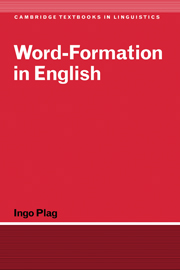Book contents
- Frontmatter
- Contents
- Preface
- Abbreviations and notational conventions
- Introduction
- 1 Basic concepts
- 2 Studying complex words
- 3 Productivity and the mental lexicon
- 4 Affixation
- 5 Derivation without affixation
- 6 Compounding
- 7 Theoretical issues: modeling word-formation
- Answer key to exercises
- References
- Subject index
- Affix index
- Author index
2 - Studying complex words
- Frontmatter
- Contents
- Preface
- Abbreviations and notational conventions
- Introduction
- 1 Basic concepts
- 2 Studying complex words
- 3 Productivity and the mental lexicon
- 4 Affixation
- 5 Derivation without affixation
- 6 Compounding
- 7 Theoretical issues: modeling word-formation
- Answer key to exercises
- References
- Subject index
- Affix index
- Author index
Summary
Outline
This chapter discusses in some detail the problems that arise with the implementation of the basic notions introduced in chapter 1 in the actual analysis of word structure in English. First the notion of the morpheme is scrutinized with its problems of the mapping of form and meaning. Then the phenomenon of base and affix allomorphy is introduced, followed by a discussion of the notion of word-formation rule. Finally, cases of multiple affixation and compounding are analyzed.
Identifying morphemes
In the previous chapter we introduced the crucial notion of the morpheme as the smallest meaningful unit. We have seen that this notion is very useful in accounting for the internal structure of many complex words (recall our examples employ-ee, invent-or, un-happy, etc.). In this section, we will look at more data and see that there are a number of problems involved with the morpheme as the central morphological unit.
The morpheme as the minimal linguistic sign
The most important characteristic of the traditional morpheme is that it is conceived of as a unit of form and meaning. For example, the morpheme un- (as in unhappy) is an entity that consists of the content or meaning on the one hand, and the sounds or letters which express this meaning on the other hand. It is a unit of form and meaning, a sign. The notion of sign may be familiar to most readers from non-linguistic contexts.
- Type
- Chapter
- Information
- Word-Formation in English , pp. 20 - 43Publisher: Cambridge University PressPrint publication year: 2003



